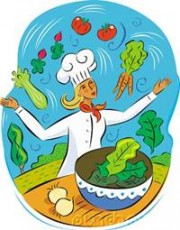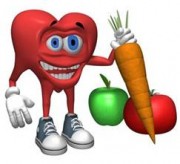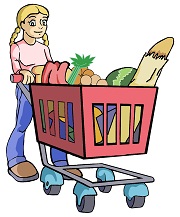 I hope you’ll want to learn more and let me help you to get into the best shape of your life.
I hope you’ll want to learn more and let me help you to get into the best shape of your life.

As part of a healthy diet, whole foods play a significant role in helping your body function at its best. There are hundreds of nutritious whole foods, but the dozen on this list do more than just have healthy nutrients, they also have healing properties.
Kiwi fruit: This tiny fruit packs an amazing amount of vitamin C (double the amount found in oranges), has more fiber than apples, and beats bananas as a high potassium food. The unique blend of phytonutrients, vitamins, and minerals found in kiwi fruit helps protect against heart disease, stroke, cancer, and respiratory disease. Kiwi fruit’s natural blood thinning properties work without the side effects of aspirin and support vascular health by reducing the formation of spontaneous blood clots, lowering LDLcholesterol, and reducing blood pressure. Studies have shown that kiwi fruit not only reduce oxidative stress and damage to your DNA but also helps damaged cells to repair themselves.
Kiwi fruit are often prescribed as part of a dietary regimen to battle cancer and heart disease, and in Chinese medicine they are used to accelerate the healing of wounds and sores.
How much: Aim to eat one to two kiwi fruit a day. California grown kiwi fruit are in season from October through May, and New Zealand kiwi fruit are available between April and November.
Tips: Kiwi fruit contain enzymes that activate once you cut the fruit, causing the flesh to tenderize. So if you’re making a fruit salad, cut the kiwifruit last.
The riper the kiwi fruit, the greater the antioxidant power, so let them ripen before you dig in.
Cherries: Cherries pack a powerful nutritional punch with a low calorie count. They’re also packed with substances that help fight inflammation and cancer. In lab studies, quercetin and ellagic acid, two compounds contained in cherries, have been shown to inhibit the growth of tumors and even cause cancer cells to commit suicide, without damaging healthy cells. Cherries also have antiviral and antibacterial properties.
Anthocyanin, another compound in cherries, is credited with lowering the uric acid levels in your blood, reducing a common cause of gout. Researchers believe anthocyanins may also reduce your risk of colon cancer. These compounds also work like a natural form of ibuprofen, reducing inflammation and curbing pain. Regular consumption may help lower risk of heart attack and stroke.
In Chinese medicine, cherries are routinely used as a remedy for gout, arthritis, and rheumatism, as well as anemia, due to their high iron content.
How much: Eat daily and keep a bag of frozen cherries in your freezer. Frozen cherries retain 100 percent of their nutritional value and make a great addition to smoothies, yogurt, and oatmeal.
Tip: Buy organic, since conventionally grown cherries can be high in pesticides.
Guavas: Guavas are a small tropical fruit that can be round, oval, or pear-shaped. They’re not all that common, so they might be hard to find, depending on where you live. Guavas contain more of the cancer fighting antioxidant lycopene than any other fruit or vegetable, and nearly 20 percent more than tomatoes. Your body can’t process much of the lycopene in tomatoes until they’re cooked as the processing helps break down tough cell walls. However, guavas’ cell structure allows the antioxidant to be absorbed whether the fruit is raw or cooked, and the whole fruit offers the nutrition without the added sodium of processed tomato products.
Lycopene protects your healthy cells from free radicals that can cause all kinds of damage, including blocked arteries, joint degeneration, nervous system problems, and even cancer. Lycopene consumption is associated with significantly lower rates of prostate cancer. Men with prostate tumors who consumed lycopene supplements showed significant improvements, such as smaller tumors and decreased malignancy. Lycopene has also been found to inhibit the growth of breast cancer cells, and research suggests that this antioxidant may also help protect against coronary heart disease.
This fruit is also packed with vitamin C and other antioxidants. Serving for serving, guava offers more than 60 percent more potassium than a banana, which can help protect against heart disease and stroke. In fact, the nutrients found in guavas have been shown to lower LDL and boost HDL cholesterol, reduce triglycerides, and lower blood pressure.
How much: Eat fresh guavas as often as you can as they are not commonly available in most stores. Guava juices are processed and sweetened, so they don’t provide the same superior nutrition that the whole, fresh fruit does. One to two guavas a day is a good goal.
Beans: Beans lower cholesterol, regulate blood sugar and insulin production, promote digestive health, and protect against cancer. If you think of fiber, protein, and antioxidants and immediately think whole grains, meats, and fruit, think again, beans offer all three in a single package.
An assortment of phytochemicals found in beans has been shown to protect cells from cancerous activity by inhibiting cancer cells from reproducing, slowing tumor growth. Researchers shows women who consumed beans at least twice a week were 24 percent less likely to develop breast cancer, and multiple studies have tied beans to a reduced risk of heart disease, type 2 diabetes, high blood pressure, and breast and colon cancers.
Beans deliver a whopping amount of antioxidants, which help prevent and fight oxidative damage. In fact, the USDA’s ranking of foods by antioxidant capacity places three varieties of beans (red beans, red kidney beans, and pinto beans) in the top four and that’s among all food groups. Beans are a great source of dietary fiber, protein, and iron. They also contain the amino acid tryptophan. Foods with high amounts of tryptophan can help regulate your appetite, aid in sleep, and improve your mood. Many are also rich in folate, which plays a significant role in heart health. And depending on the type of bean you choose, you’ll also get decent amounts of potassium, magnesium, vitamin B1 and B2, and vitamin K. Soybeans are a great source of omega-3 fatty acids.
In Chinese medicine, various types of beans have been used to treat alcoholism, food poisoning, edema (particularly in the legs), high blood pressure, diarrhea, laryngitis, kidney stones, rheumatism, and dozens of other conditions.
How much: Try to eat two servings of beans per week.
Tip: Adzuki and mung beans are among the most easily digested. Pinto, kidney, navy, garbanzo, Lima, and black beans are more difficult to digest.
Watercress: Watercress is about as close as you can get to a calorie free food. Calorie for calorie, it provides four times the calcium of 2 percent milk. Ounce for ounce, it offers as much vitamin C as an orange and more iron than spinach. It’s packed with vitamin A and has lots of vitamin K, along with multiple antioxidant carotenoids and protective phytochemicals.
The nutrients in watercress protect against cancer and macular degeneration, help build the immune system, and support bone health. The iron helps red blood cells carry oxygen to your body’s tissues for energy. The phytochemicals in watercress battle cancer in three ways: killing cancer cells, blocking carcinogens, and protecting healthy cells from carcinogens. They’ve also been shown to help prevent lung and esophageal cancer and can help lower your risk for other cancers.
In Chinese medicine, watercress is thought to help reduce tumors, improve night vision, and stimulate bile production (improving digestion and settling intestinal gas). It’s used as a remedy for jaundice, urinary difficulty, sore throat, mumps, and bad breath.
How much: Eat daily if you can. You can find it year round in many grocery stores and at your local farmers market.
Tips: You can cook it, but watercress is better for you when you eat it raw. Tuck it into a sandwich in place of lettuce.
Toss it with your favorite vegetables and eat it in a salad.
Use watercress as a wonderfully detoxifying ingredient in juice or smoothies.
Spinach: Spinach protects against eye disease and vision loss, it’s good for brain function, it guards against colon, prostate, and breast cancers, it protects against heart disease, stroke, and dementia. It lowers blood pressure, it’s anti-inflammatory and it’s great for bone health. Spinach has an amazing array of nutrients, including high amounts of vitamin K, calcium, vitamin A, vitamin C, folate, magnesium, and iron.
A carotenoid found in spinach not only kills prostate cancer cells, it also prevents them from multiplying. Folate promotes vascular health by lowering homocysteine, an amino acid that, at high levels, raises the risk of dementia and cardiovascular disease, including heart disease and stroke. Folate has also been shown to reduce the risk of developing colorectal, ovarian, and breast cancers and to help stop uncontrolled cell growth, one of the primary characteristics of all cancers. The vitamin C and beta-carotene in spinach protect against colon cancer in addition to fighting inflammation, making them key components of brain health, particularly in older adults.
Spinach is loaded with vitamin K (one cup of cooked spinach provides 1,111 percent of the recommended daily amount!), which builds strong bones by helping calcium adhere to your bones. Spinach is also rich in lutein, which protects against age related macular degeneration, and it may help prevent heart attacks by keeping artery walls clear of cholesterol buildup.
How much: Fresh spinach should be a daily staple in your diet and aim for a few ounces, raw or lightly steamed, every day.
Tips: Add a handful of fresh spinach to your next fruit smoothie. It’ll change the color but not the taste.
Conventionally grown spinach is susceptible to pesticide residue; stick to organic.
Onions: Onions contain potent cancer-fighting enzymes, onion consumption has been shown to help lower the risk of prostate and esophageal cancers and has also been linked to reduced mortality from coronary heart disease. Research suggests that they may help protect against stomach cancer. Onions contain sulfides that help lower blood pressure and cholesterol, as well as a peptide that may help prevent bone loss by inhibiting the loss of calcium and other bone minerals.
Onions have super antioxidant power. They contain quercetin, a natural antihistamine that reduces airway inflammation and helps relieve symptoms of allergies and hay fever. Onions also boast high levels of vitamin C, which, along with the quercetin, battles cold and flu symptoms. Onions’ anti-inflammatory properties help fight the pain and swelling associated with osteo- and rheumatoid arthritis. Onions are also extremely rich in sulfur and they have antibiotic and antiviral properties, making them excellent for people who consume a diet high in protein, fat, or sugar, as they help cleanse the arteries and impede the growth of viruses, yeasts, and other disease causing agents, which can build up in an imbalanced diet.
How much: Add a few onions to your weekly grocery list and try to eat a little bit every day. All varieties are extremely good for you, but shallots and yellow onions lead the pack in antioxidant activity. Raw onions provide the best nutrition, but they’re still great for you when they’re lightly cooked. And cooking meat at high temperatures (such as on a grill) with onions can help reduce or counteract carcinogens produced by the meat.
Tip: Onions should be stored at room temperature, but if they bother your eyes when you cut them, try refrigerating them for an hour before cutting.
Carrots: Carrots are a great source of the potent antioxidants known as carotenoids. Diets high in carotenoids have been tied to a decreased risk in postmenopausal breast cancer as well as cancers of the bladder, cervix, prostate, colon, larynx, and esophagus. Conversely, diets low in carotenoids have been associated with chronic disease, including heart disease and various cancers. Research suggests that just one carrot per day could reduce your risk of lung cancer by half. Carrots may also reduce your risk of kidney and ovarian cancers. In addition to fighting cancer, the nutrients in carrots inhibit cardiovascular disease, stimulate the immune system, promote colon health, and support ear and eye health.
Carrots contain calcium, potassium, magnesium, phosphorus, fiber, vitamin C, and an incredible amount of vitamin A. The alpha-carotene in carrots has shown promise in inhibiting tumor growth. Carrots also contain the carotenoids lutein and zeaxanthin, which work together to promote eye health and prevent macular degeneration and cataracts.
In Chinese medicine, carrots are used to treat rheumatism, kidney stones, tumors, indigestion, diarrhea, night blindness, ear infections, earaches, deafness, skin lesions, urinary tract infections, coughs, and constipation.
How much: Eat a serving of carrots each day. Carrots are good for you whether they’re raw or lightly cooked. Cooking helps break down the tough fiber, making some of the nutrients more easily absorbed. For the best nutrition, go for whole carrots that are firm and fresh-looking. Precut baby carrots are made from whole carrots and, although they’re convenient, they tend to lose important nutrients during processing.
Tips: Remove carrot tops before storing them in the fridge, as the tops drain moisture from the roots and will cause the carrots to wilt.
Buy organic; conventionally grown carrots frequently show high pesticide residues.
Cabbage: Cabbage is a great source of vitamins K and C. One cup supplies 91 percent of the recommended daily amount for vitamin K, 50 percent of vitamin C, good amounts of fiber, and decent scores of manganese, vitamin B6, folate, and more—and it’ll only cost you about 33 calories. Calorie for calorie, cabbage offers 11 percent more vitamin C than oranges.
Cabbage contains high levels of antioxidant sulforaphanes that not only fight free radicals before they damage DNA but also stimulate enzymes that detoxify carcinogens in the body. Researchers believe this one-two approach may contribute to the apparent ability of cruciferous vegetables to reduce the risk of cancer more effectively than any other plant food group. Studies point to a strong association between diets high in cruciferous vegetables and a low incidence of lung, colon, breast, ovarian, and bladder cancers.
Cabbage builds strong bones, dampens allergic reactions, reduces inflammation, and promotes gastrointestinal health. Cabbage is routinely juiced as a natural remedy for healing peptic ulcers due to its high glutamine content. It also provides significant cardiovascular benefit by preventing plaque formation in the blood vessels.
In Chinese medicine, cabbage is used to treat constipation, the common cold, whooping cough, depression and irritability, and stomach ulcers. When eaten and used as a poultice, as a dual treatment, cabbage is helpful for healing bedsores, varicose veins, and arthritis.
How much: The more cabbage you can include in your diet, the better.
Tips: Try raw sauerkraut. It has all the health properties of cabbage, plus some potent probiotics, which are excellent for digestive health.
Use the whole cabbage; the outer leaves contain a third more calcium than the inner leaves.
Both are nutritional stars, but red cabbages are far superior to the white variety, with about seven times more vitamin C and more than four times the polyphenols, which protect cells from oxidative stress and cancer.
Broccoli: A single cup of steamed broccoli provides more than 200 percent of the RDA for vitamin C (again, more than oranges), nearly as much of vitamin K, and about half of the daily allowance for vitamin A, along with plentiful folate, fiber, sulfur, iron, B vitamins, and a whole host of other important nutrients. Calorie for calorie, broccoli contains about twice the amount of protein as steak and a lot more protective phytonutrients.
Broccoli’s phytochemicals fight cancer by neutralizing carcinogens and accelerating their elimination from the body, in addition to inhibiting tumors caused by chemical carcinogens. Studies show evidence that these substances help prevent lung and esophageal cancers and may play a role in lowering the risk of other cancers, including gastrointestinal cancer.
Phytonutrients called indoles found in broccoli help protect against prostate, gastric, skin, breast, and cervical cancers. Some research suggests that indoles also protect the structure of DNA and may reduce the risk of prostate cancer. Extensive studies have linked broccoli to a 20 percent reduction in heart disease risk.
In Chinese medicine, broccoli is used to treat eye inflammation.
How much: Try to eat a little broccoli every day. Like many other vegetables, broccoli provides fantastic nutrition both in its raw form and when it’s properly cooked. Cooking reduces some of broccoli’s anticancer components, but lightly steaming it will preserve most of the nutrients. Frozen broccoli is a good substitute.
Tip: Steaming or cooking broccoli lightly releases the maximum amount of the antioxidant sulforaphane.
Kale: Kale is highly nutritious, has powerful antioxidant properties, and is anti-inflammatory. One cup of cooked kale contains an astounding 1,328 percent of the RDA for vitamin K, 192 percent of the RDA for vitamin A, and 89 percent of the RDA for vitamin C. It’s also a good source of calcium and iron.
Kale is in the same plant family as broccoli and cabbage and it contains high levels of the cancer-fighting compound sulforaphane, which guards against prostate, gastric, skin, and breast cancers by boosting your body’s detoxification enzymes and fighting free radicals in your body. The indoles in kale have been shown to protect against breast, cervical, and colon cancers. The vitamin K in kale promotes blood clotting, protects the heart, and helps build strong bones by anchoring calcium to the bone. It also has more antioxidant power than spinach, protecting against free-radical damage. Kale is extra rich in beta-carotene (containing seven times as much as does broccoli), lutein, and zeaxanthin (10 times the amount in broccoli). In Chinese medicine, kale is used to help ease lung congestion.
How much: The more kale you can eat, the better.
Tips: Kale’s growing season extends nearly year-round; the only time it’s out of season is summer, when plenty of other leafy greens are available.
Steam or sauté kale on its own, or add it to soups and stews. Cooking helps tenderize the leaves.
Kale is also a great addition when it’s blended in fruit smoothies or juiced with other vegetables.
Dandelion: The pesky weed has a long history of being used as a healing herb in cultures around the globe. One cup of raw dandelion greens provides 535 percent of the RDA of vitamin K and 112 percent of the RDA for vitamin A. Dandelion greens are also a good source of vitamin C, calcium, iron, fiber, and potassium. Among all foods, it’s one of the richest sources of vitamin A, among all green vegetables. It’s also one of the best sources of beta-carotene.
Dandelion has been used for centuries to treat hepatitis, kidney, and liver disorders such as kidney stones, jaundice, and cirrhosis. It’s routinely prescribed as a natural treatment for hepatitis C, anemia, and liver detoxification (poor liver function has been linked to numerous conditions, from indigestion and hepatitis to irritability and depression). As a natural diuretic, dandelion supports the entire digestive system and increases urine output, helping flush toxins and excess salt from the kidneys. The naturally occurring potassium in dandelions helps prevent the loss of potassium that can occur with pharmaceutical diuretics.
Dandelion promotes digestive health by stimulating bile production, resulting in a gentle laxative effect. Inulin, a naturally occurring soluble fiber in dandelion, further aids digestion by feeding the healthy probiotic bacteria in the intestines. It also increases calcium absorption and has a beneficial effect on blood sugar levels, therefore being useful in treating diabetes. Both the dandelion leaves and root are used to treat heartburn and indigestion. The pectin in dandelion relieves constipation and, in combination with vitamin C, reduces cholesterol. Dandelion is excellent for reducing edema, bloating, and water retention. It can also help reduce high blood pressure. On top of all that, dandelion contains multiple antidiarrheal and antibacterial properties.
In Chinese medicine, dandelion is used in combination with other herbs to treat hepatitis and upper respiratory tract infections such as bronchitis and pneumonia. The sap from the stem and root is a topical remedy for warts.
How much: Dandelion greens are considered a specialty item in some areas and therefore can be difficult to find. They also have a pungent taste, and people tend to love or hate the flavor. If you can find fresh dandelion greens and you enjoy the taste, make them a regular part of your diet.
Tips: Use the root in soups or sauté it on its own. If the raw leaves are too bitter for you, try them lightly steamed or sautéed.
I know you want to get in shape and look great. Whatever your fitness goal…to slim down…gain muscle…tone your arms or flatten your tummy…I’m here to help you accomplish your goals and to improve your fitness level. If you have enjoyed this article and the many other free features on my site, and would like some more comprehensive information such as fitness books and CD’s to aid you in achieving your health and fitness goals, please visit my ONLINE STORE where you will find innovative natural health and beauty products to help you become the BEST YOU CAN BE !

 I hope you’ll want to learn more and let me help you to get into the best shape of your life.
I hope you’ll want to learn more and let me help you to get into the best shape of your life.

 I hope you’ll want to learn more and let me help you to get into the best shape of your life.
I hope you’ll want to learn more and let me help you to get into the best shape of your life. I hope you’ll want to learn more and let me help you to get into the best shape of your life.
I hope you’ll want to learn more and let me help you to get into the best shape of your life. I hope you’ll want to learn more and let me help you to get into the best shape of your life.
I hope you’ll want to learn more and let me help you to get into the best shape of your life. The following article is a small excerpt from one of my books. I hope you’ll want to learn more and let me help you to get into the best shape of your life.
The following article is a small excerpt from one of my books. I hope you’ll want to learn more and let me help you to get into the best shape of your life.